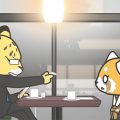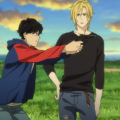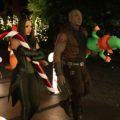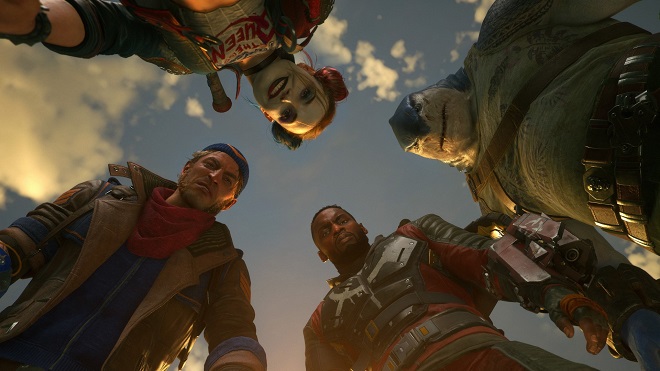Quarantine Control #152: Aggressively Fearless Adventures

As we’re quickly approaching the third anniversary of when COVID-19 cases started prominently appearing around the world, which informed everyone that this was a Big Deal™, the topic of lockdowns is once again in the public conversation. Pin that on Woody Harrelson, who used his monologue on Saturday Night Live to rant about forced vaccinations and lockdowns, invited by staffers who had to know he’s been a crank for years. The comments have revived a conversation that was always inane. Lockdowns in the US lasted for only a month-and-a-half at most during the pandemic’s start, yet these people act like they went on for a year or two. We are, predictably, set to celebrate this occasion in the worst and dumbest way.
Geoffrey Barnes
I’m going to post here about something I haven’t done in years, even since the pandemic started: I watched a tokusatsu work. I can’t answer why it’s taken so long for me to come back to one despite having ample time and opportunity to do so, but goddamn did I miss it.
Kamen Rider Kuuga (2000)
Source: Tubi
Episodes: 49
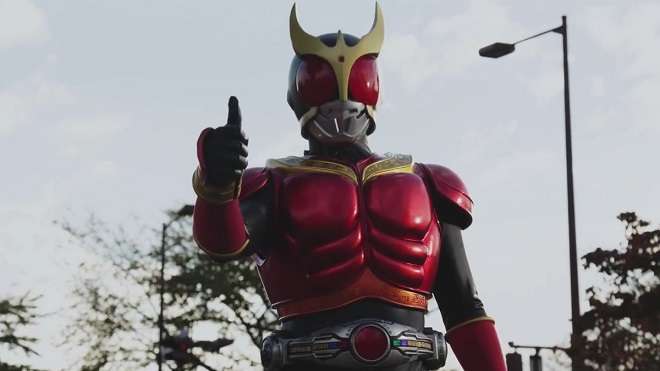
I’ve long felt that I need to see more Kamen Rider, but it’s taken me time to get back around to them. I’m pinning part of this on just how much entertainment is competing for my attention, so much that even someone with infinite free time couldn’t consume it all. The other part can be pinned on the series simply not being available legally in the United States, and it largely still isn’t. But now, for whatever reason, felt like the best opportunity to tackle another work in the series, and there wasn’t a better one to restart than with Kamen Rider Kuuga. This was the first Kamen Rider series to air on TV in in over a decade when it did so in Japan in 2000, which served as a reboot that didn’t require knowledge of previous lengthy shows. Folks, it is good stuff.
Kuuga primary focuses on protagonist Yusuke Godai (Joe Odagiri), a 24-year-old adventurer who occasionally works in small restaurant Pole Pole. Godai happens upon the Arcle belt that contains the Spirit Stone Amadam after it’s excavated from a cave, which strikes an immediate bond and bestows upon him the power to become Kuuga. He soon learns that his mission is to defeat the resurrected Grongi tribe, once defeated by a previous Kuuga in more ancient times. The Grongi are sociopathic monsters who compete among each other to kill as many humans within Japan as possible, and Godai, alongside the police, seek to stop them before too much chaos to control ensues.
Kamen Rider Kuuga is far more entertaining in practice compared to the slightly-boring explanation. Its storytelling is endearing to the point that it becomes memorable. Godai’s intoxicating optimism is his most appealing factor, and what keeps the group of friends and family around them together. The level of fear and chaos the Grongi unleash in Japan is grim for a series primarily aimed at kids, and often gets violent enough to challenge primetime shows that aired at the time. But Godai never frets too heavily, and seeks to help as many people as he can as he simultaneously comes to understand Kuuga’s power.
He’s assisted by a group of similarly endearing characters the story focuses on, including police inspector Kaoru Ichijo (Shingo Katsurayama), who frequently joins in on the action to help Godai nearly as much has he helps him, often using his police resources to inform him of where Grongi have emerged. Others include helpful graduate student archeologist and Godai friend Sakurako Sawatari (Kazumi Murata), Godai’s younger sister and teacher Minori Godai (Wakana Chizaki), and police science researcher Hikari Enokida (Kaori Mizushima). There’s also French-American graduate student Jean Michel Sorrel (Serge Vasilov — who is Romanian), who got a kick out of me whenever he occasionally drops lines in English to simply establish that he speaks the language fluently. This is only cracking the surface of the cast, one far too extensive for me to delve into them all here. But the benefit of this being a long-ish series at 49 episodes is how there’s more than enough time for the production team to develop and make the viewer care about all of them, which it succeeds at.
Kamen Rider Kuuga is, in fact, tokusatsu at is very best. The story may be often melodramatic, and the acting isn’t always the best — to a comedic degree with the Grongi in human form. The budget is as high as expected for a tokusatsu of the time through being very evidently low. This, combined with the extremely 2000 VFX, including PSOne-tier monster explosions, makes it look chintzy. The structure itself is also predictable, with Kuuga and the police up against a new murder-happy Grongi around every two episodes. Whenever Kuuga struggles, there’s a new power-up waiting to be learned right around the figurative corner.
It’s a testament to how good the writing is and how endearing the characters are that none of those supposed presentation “flaws” matter in the least. The story continues at a brisk pace after the starting episodes, alongside fun and entertaining fights between Kuuga in his spiffy outfits and the Grongi.
As a 49-episode series, pacing issues were inevitable. The storytelling moves slowly in the first five episodes, as Godai learns who he’s fighting against and what he’s fighting for. (He’s no Zero.) It also has two recap episodes; the first one (episode 17) is skippable for binging purposes, but the second (episode 31) is one of the worst kinds of recaps in how it also includes snippets of new and essential story content. I’m also aware that not everyone will enjoy how cheap it looks, particularly in previews. But trust me when I say that the essential elements are so top-notch enough that the budget becomes less than a tertiary concern.
Kamen Rider Kuuga can be a bit overly dramatic at times, with the combination of that element and the high framerate occasionally (though hardly often) giving it a soap opera feel. It was also evidently made on a budget that tokusatsu works are wont to receive, on a shoestring and a paperclip. But it’s great, and I fully understand why this series relaunched the brand. It’s a shame that more Kamen Rider works (and other tokusatsu TV works like several Super Sentai shows and Garo) aren’t available for legal streaming or home video purchase outside in most western territories, but Shout! Factory knew to pick a good one as an entry barrier. I will keep my fingers crossed that follow-up Kamen Rider Agito will be available on more services soon, alongside others.
Angela Moseley
Remember my small tirade about being tired of Netflix and finally canceling my service? I did say that I would turn the service off and on as needed. My stand against the big streaming service only lasted for about two weeks. Shameful, I know.
Aggretsuko, Season 5 (2023)
Source: Netflix
Episodes: 10
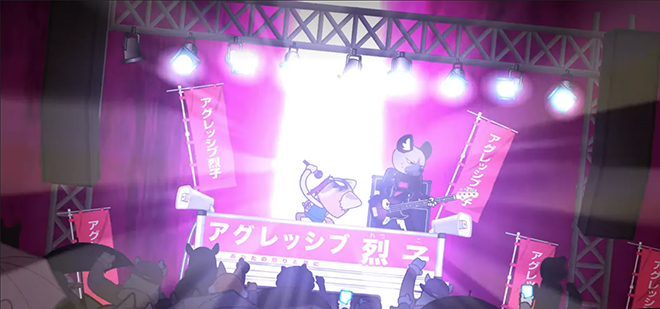
I admit I’ve recently been way too busy for my own good. I knew the fifth season of Aggretsuko was coming in February, but I somehow missed it would be the show’s final season. I was completely unaware until I started fact-checking for this article. Good thing I double-checked too, because I now feel slightly differently now that I know we won’t be getting more Aggretsuko. I went into the season feeling more indifferent than excited because for all of Retsuko’s adventures, the last season left me feeling somewhat frustrated. I also somehow forgot that she and Haida hooked up. Maybe I’m bad at paying attention, or maybe the season 4 finale was just that underwhelming. I certainly know that it wasn’t covered on past QC entries. My bad.
After the previous accounting scandal at the office, Haida quit. Fortunately, he’s gotten together with Retsuko like he’s always wanted. Unfortunately, he still doesn’t have a job and worse yet, he spends his job search time distracted by online gaming with a friend. Things take a turn for the worse when the hyena blows through his savings on in-game purchases, and then he finds out he’s being evicted from his apartment. Having nowhere else to go and not wanting to bother Retsuko, Haida opts to live in an internet café. There he meets Shikabane, his online gaming friend. He discovers that his friend is female and also lives at the internet café. Feeling bad about egging on Haida’s bad gaming habits, the skunk helps set him up on the path to getting back on his feet.
Fenneko ultimately discovers what happened to Haida and the entire office finds out. Retsuko finally confronts him and allows him to move in with her. A month passes by and he still hasn’t landed a job. Meanwhile, the pair end up meeting each other’s parents. Retsuko’s parents aren’t thrilled to learn that Haida is unemployed, while Haida breaks off with his family, after being told that his younger brother, Jiro is running for his father’s government seat. Shortly after this, Haida is given the inspiration to search for a job in IT, rather than finance, as the industry suits him better.
Just as the pair are getting back on track, Ikari, a member of the National Diet, specifically the Rage party, tracks down Retsuko. (Ikari’s round cat face looks like a testicle when he’s angry. Fitting, because this character is also a bit of dick.) He urges the red panda to run for an open district seat, which would put her in direct competition with Jiro. Retsuko is unsure about running, so all of her friends, co-workers, and Haida urge her to fight for the seat.
Before going into the final season of Aggretsuko, I saw lots of complaints on social media (i.e., Twitter) about how Haida stole the series from the titular red panda. I honestly think his increased screen time depends on how much you like him. He certainly rubbed me the wrong way in season 4, and how much he generally pined over Retsuko without ever asking her out in previous seasons. As her boyfriend, I didn’t mind the focus shifting from her to him, as his situation interested me. In this season he becomes a character who finally decides what he wants from life instead of being carried along the current. Again, if you fundamentally dislike Haida, I can see being annoyed with the shift in character focus.
My biggest points of frustration were with the rushed nature of the series finale. As much as I liked Haida’s adventures, I do feel like they came at the detriment of Retsuko running for office. It felt like the episodes spent on Haida could have either been shortened, or season 5 could have used more than 10 episodes. The season taking a political turn with Retsuko and Haida clashing with Jiro made sense. Although having Retsuko run for office in the last three episodes felt like a sucker punch. When everything was all said and done, I didn’t feel a good sense of closure. Sure, we received glimpses of what some characters were up to, but it didn’t feel like a proper goodbye. I wanted to know more about Shirobane and Retsuko’s budding friendship, whether Retsuko returned to her office job, and where Haida ultimately landed for work.
Season 5 pulled my feelings in different directions. On one hand, I do like how Retsuko and Haida’s relationship has finally gone somewhere serious. I also like the show’s critique of how difficult it can be to participate in society, especially if you don’t have much to look forward to. On the political side, I really liked the criticism of the older generations holding on to power way too long at the expense of younger generations. On the downsides, see my complaints above about how rushed the ending felt. I’d be less bummed out if some of my questions were answered in an epilogue episode. I had originally wanted a sixth season, but thinking about it, I’d still rather see Aggretsuko end on a positive note. I’ve seen way too many series across various mediums that have overstayed their welcome.
Overall, this anime has been mostly great from start to finish. It has been a refreshing break from the norm of seeing teenagers in high school. Not only do I appreciate the cute furry aesthetic, but I love this show for tackling universal societal issues that most adults face in some form. I do recommend at least trying Aggretsuko out, especially now that the show has ended.
Joseph Daniels
Last week, I made a bit of a mistake. I had planned to write about something entirely different, then forgot completely about it. Oops. I’d better correct that mistake now.
The New Adventures of Winnie the Pooh
Episode: Find Her, Keep Her
Original Airdate: February 7, 1988
Source: Disney+
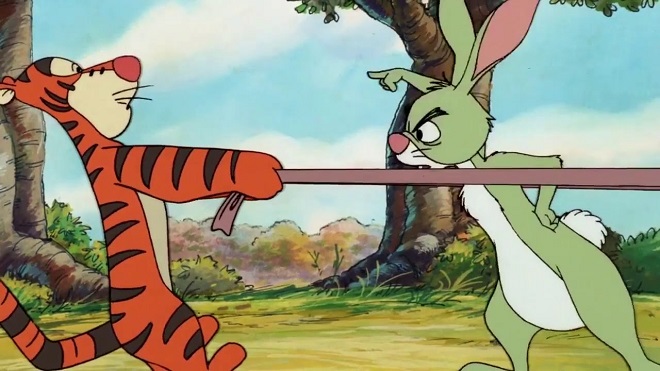
It is very much appropriate, during the Year of the Rabbit, to call attention to one of my favourite Rabbit episodes in the entire Winnie the Pooh franchise. Not only did it introduce my favourite minor character to the series, it’s a fantastic story about learning to let go of someone you love, and trusting that they’ll come back to you. It’s one of the most difficult things for a parent to do, assuming the parent and their child have a good relationship.
The episode begins with Rabbit keeping a carrot warm in winter while his friends look on, for some reason. It’s unclear to me how this one carrot managed to miss the harvest completely, but keep in mind that the characters’ lives are basically run by the imagination of a school-aged boy who probably didn’t grow up on a farm and might not have had a garden to tend to.
A cry for help draws everyone’s attention, and it’s soon discovered that a baby bird is lost in the winter storm… still in her nest. One impromptu rescue later, Rabbit takes charge of the bird, a bluebird chick named Kessie, likely out of fear of what might happen to the bird if Piglet, Tigger and Pooh Bear tried. What’s funny here is that Rabbit declares there’s no one in the Hundred Acre Wood that knows more about baby birds than he does. I’m sure Owl would like a word with him, but I assume Christopher Robin wasn’t playing with his owl plush that day.
Rabbit certainly tries his best, but it proves to be more work than he was expecting. He tasks Pooh Bear and Piglet with giving Kessie a bath, but due to difficulties with the “sope”, Kessie ends up floating away in a bubble, giving Rabbit quite the scare. Rabbit is afraid of heights in this episode, and considers it to be far too dangerous for Kessie to be so high off the ground. I really need to watch the rest of the series again to see if his fear of heights continues or if it was just a one time thing. It’s been a while since I watched the entire series from beginning to end.
As the months go by, Kessie is taught how to tend to a garden and helps Rabbit out, but a mishap with Tigger gives Kessie incentive to need to fly, which she gets a very nearly literal crash course in, thanks to a timely intervention from Owl. Owl also reveals the migratory nature of birds to Rabbit, who does not take the news well. He’s probably so used to Owl staying for the winter that he doesn’t even think about what other birds do when the weather turns cold.
Unfortunately, Rabbit smothers her even more as the months go by, and Kessie longs for the open sky. Her heart aches because she loves Rabbit, but she also wants to learn to fly. Despite the initial lesson from Owl, Rabbit’s on-going discouragement prevents her from getting any better, until Kessie rescues her from a fall. It seems like Kessie only learns to fly when it’s absolutely necessary, reaching deep inside of herself to discover life-saving epiphanies. The first anime hero I ever watched was in an American cartoon animated by Disney.
Possibly. I can’t remember when I watched Astro Boy, but I did and I never really followed what was going on because I was a bit young for it. I can’t guarantee that they didn’t also butcher it because that’s generally what happened when anime was brought over from Japan in the 1980s and 1990s.
Despite the fact that Kessie saved his life, Rabbit’s heart breaks when he hears how excited Kessie is to fly south for the winter. He’d been living in denial ever since he’d first learned about the possibility from Owl and had been trying everything short of locking Kessie in a tower, Mother Gothel style, to keep her from flying. Depressed and devastated, Rabbit withdraws completely, upsetting Kessie greatly for the rest of her stay in the Hundred Acre Wood, and when the day comes for Kessie to fly south, Rabbit is nowhere to be seen.
Everyone else sees Kessie off, suggesting that everyone actually did have a hand in taking care of her. She might’ve lived with Rabbit, and Rabbit doubted anyone else was capable, but clearly they were. I kind of wish that the year hadn’t passed by in a single episode, but for the purpose of the story, it sort of had to. The series is also much more light hearted, typically, and didn’t try to keep a single plot thread going over the course of multiple episodes. The trend to feature a stronger sense of continuity between episodes, as has been seen in shows like The Owl House, The Lion Guard (after a fashion, anyway) or the DuckTales reboot, is a bit more of a recent trend. When Gargoyles did it in the mid 1990s, it was the exception rather than the rule. It aired alongside episodic fare like Goof Troop, Bonkers and The Lion King’s Timon & Pumbaa.
Kessie must’ve been looking for Rabbit, because the two do indeed get to share a goodbye before she flies south. At the end of the episode, Rabbit is seen sitting in the snow, watching for Kessie’s return.
We then don’t see Kessie again until the end of season three, and her return only warrants a half episode. It’s a little disappointing to know that a character who impacted everyone’s lives as much as Kessie did only exists for one and a half episodes in the entire series. She’s an original character who didn’t appear in the books, but surely Kessie could’ve appeared in more episodes. It’s not like Disney wasn’t afraid of adding new characters. Gopher is a prominent character who appears in Disney’s version of the Hundred Acre Wood and he never appeared in the books.
She does appear in specials, and she was finally promoted to the main cast in the much more juvenile series The Book of Pooh, but then has never been seen again. Most notably, she’s absent from the Kingdom Hearts games (and Gopher shows up!), but then so is Rajah despite how often Sora visits Agrabah.
It’s actually pretty interesting to look back on this episode and realize that Rabbit learns to love someone else and absolutely does not take it well. This would come back in “A Bird in the Hand”, where he still smothers her and it leads to her running away. Maybe Rabbit was not the best choice of guardian for Kessie, but given the options, it wasn’t like there was a good selection in the Hundred Acre Wood. Out of everyone, I probably would’ve figured Owl would be the one best suited to take care of her, and not just because of them both being birds. He tries to be wise, but his is the kind of wisdom that a young boy imagines is wise. Still, as Christopher Robin grew up, maybe Owl’s wisdom would also evolve and so in his imagination, Kessie would be getting the right kinds of lessons. He just wouldn’t be able to portray them very well. This is also likely why everything’s spelled a little off in the series, because Christopher Robin makes all the props himself, so the box of soap becomes a box of sope. This is also why I don’t bat an eye when Rabbit contemplates planting in winter so that his new crop of carrots would be ready in spring. This is how Christopher Robin imagines crops work.
Ultimately, this is pretty much why I let the entire Winnie the Pooh franchise get away with everything it does. We’re basically watching a bunch of stuffed toys having adventures, and sometimes Christopher Robin self-inserts. Everything he doesn’t know, he just makes up. I know when I was that age, I would do the same. It was also an age before the Internet, so you really couldn’t look up anything on-line. Christopher Robin did know about the migratory patterns of birds, and also knew that Owl didn’t fly south, but anything that doesn’t jive with real world facts can definitely be hand waved as Christopher Robin not knowing something.
This was always my favourite episode of the series, mostly due to the presence of Kessie. I think I may have subconsciously been inspired by her when I first came up with the original version of my Final Fantasy XIV character in 2003. Sara has definitely grown up since then and her Final Fantasy XIV version is now kicking ass and taking names in Eorzea. I wonder if Christopher Robin, the Disney version anyway, might’ve used Kessie in something when he grew up, too. It would be such a shame if he put all of his toys away and didn’t even acknowledge them anymore.
Such a shame.
It would be nice to never hear about lockdowns again, but there are certain people who will keep this up for as long as it advances their arguments about us living in tyranny. There sure are tyrants around us, but not the ones they’re willing to discuss in a negative manner. Until next week.

